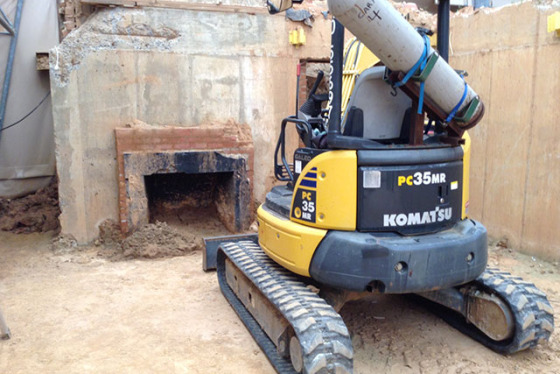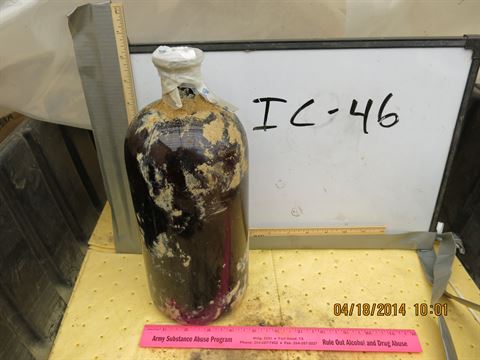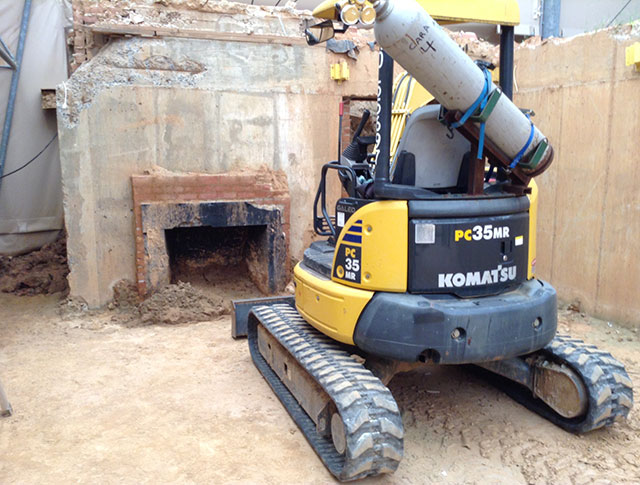WASHINGTON — The recent discovery of an unknown substance containing low levels of mustard gas has temporarily halted the cleanup of a World War I chemical weapons testing site found under a house near American University.
Five years after the house at 4825 Glenbrook Rd. NW, was removed, in the Spring Valley neighborhood, the U.S. Army Corps of Engineers tells WTOP the final stages of the cleanup of toxic munitions is in the midst of a brief pause, after crews found an unknown black substance mixed with soil on the property.
“We don’t know what it is, but it has low levels of mustard,” said Chris Gardner, spokesman with the Corps’ Baltimore District. In functioning weapons, mustard gas can cause large blisters on skin and in lungs.
After the April discovery of the substance, the Army Corps, Environmental Protection Agency and Department of Energy and Environment performed additional soil sampling, and decided to pause the cleanup, to factor-in plans for handling the soil.
The project partners determined the low risk of the soil did not require enlarging the fenced-in safety zone.
The disruption comes as the cleanup enters the final stages of a decades-long drama in the pricey Spring Valley neighborhood.
The Spring Valley project began in 1993, when a contractor unearthed buried military ordnance on nearby 52nd Court NW. During World War I the U.S. government researched and tested chemical agents, equipment, and munitions at the American University Experiment Station.
Since 2000, more than 500 munition items, 400 pounds of laboratory glassware, and 100 tons of contaminated soil have been removed from the site, according to the Corps.
The former owner of the home filed a federal lawsuit, claiming family members got sick from chemicals buried under it. A federal judge dismissed the suit in 2003, and a federal appeals court affirmed the dismissal.
From 2013 to 2016, the project took place inside a large tent-like enclosure, called an engineering control structure, which had a chemical agent filtration system that kept the structure under negative pressure at all times.
With near-real-time air monitoring, neighbors were advised of a shelter-in-place program, which would involve sirens and phone calls.
Gardner said the shelter-in-place plans never had to be enacted during the riskiest segment of the cleanup.
When the cleanup continues, Gardner said crews will wear construction site standard safety equipment, with the addition of a paper Tyvek suit, booties and an extra pair of gloves. If air-monitoring detects something, crews can increase their safety equipment, including a full-face respirator.
In 2014, WTOP reported the cleanup faced up to a three-year delay.
Since the beginning of the project, the Army Corps of Engineers has said that after the cleanup it will restore the property to residential standards, which would enable unrestricted future use of the property.
“We’ll be doing simple planting, basically turning it into big lawn,” said Gardner.
Over the years, some neighbors expressed concern for their family’s health, and property values of their multimillion-dollar homes. There is no indication anyone has suffered health problems during the cleanup.
Gardner said the project will likely resume by the end of May or beginning of June.
“Right now we’re hoping to finish excavation this summer, and our goal is to finish restoration of the property by the end of summer so it can be returned to the property owner for whatever use they would like,” said Gardner.
The property is now owned by American University.









